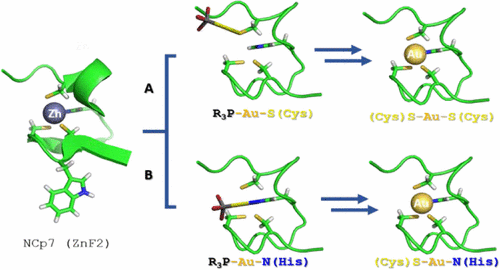当前位置:
X-MOL 学术
›
Inorg. Chem.
›
论文详情
Our official English website, www.x-mol.net, welcomes your
feedback! (Note: you will need to create a separate account there.)
Probing the HIV-1 NCp7 Nucleocapsid Protein with Site-Specific Gold(I)–Phosphine Complexes
Inorganic Chemistry ( IF 4.3 ) Pub Date : 2017-09-22 00:00:00 , DOI: 10.1021/acs.inorgchem.7b01762 Raphael E. F. de Paiva 1, 2 , Zhifeng Du 1 , Erica J. Peterson 1 , Pedro P. Corbi 2 , Nicholas P. Farrell 1
Inorganic Chemistry ( IF 4.3 ) Pub Date : 2017-09-22 00:00:00 , DOI: 10.1021/acs.inorgchem.7b01762 Raphael E. F. de Paiva 1, 2 , Zhifeng Du 1 , Erica J. Peterson 1 , Pedro P. Corbi 2 , Nicholas P. Farrell 1
Affiliation

|
In this work, we examined a series of thiophilic Au(I) compounds based on [Au(L)(PR3)] (L = Cl–, 4-dimethylaminopyridine (dmap); R= ethyl (Et), cyclohexyl (Cy)) for chemoselective auration of the C-terminal HIV nucleocapsid protein NCp7 F2 and the “full” HIV NCp7 (NC, zinc finger (ZnF)) as probes of nucleocapsid topography. The choice of phosphine allowed electronic and steric effects to be considered. The use of the heterocycle “leaving group” allowed us to study the effect of possible π-stacking with the essential tryptophan residue of NC on the reactivity and selectivity, mimicking the naturally occurring interaction between the zinc finger and nucleic acids. We also examined for comparison the “standard” gold–phosphine compound auranofin, which contains an S-bound glucose coordinated to the {Au(PEt3)} moiety. Both the nature of the phosphine and the nature of L affect the reactivity with the C-terminal NCp7 F2 and the “full” NC. 31P NMR spectroscopy showed the formation of long-lived {Au(PR3)}–ZnF species in all cases, but in the case of NCp7 F2, a selective interaction in the presence of the dmap ligand was observed. In the case of auranofin, an unusual Au–His (rather than Au–Cys) coordination was indicated on NC. The overall results suggest that it is useful to consider three aspects of zinc finger structure in considering the profile of chemical reactivity: (i) the zinc-bound cysteines as primary nucleophiles; (ii) the zinc-bound histidine as a “spectator” ligand; and (iii) ancillary groups not bound to Zn but essential for ZnF function such as the essential tryptophan in NCp7 F2 and NC. Modification of fully functional NC zinc finger by the Cy3P-containing species confirmed the inhibition of the NC–SL2 DNA interaction, as evaluated by fluorescence polarization.
中文翻译:

用特定于位点的金(I)-膦复合物探测HIV-1 NCp7核衣壳蛋白
在这项工作中,我们研究了基于[Au(L)(PR 3)](L = Cl –,4-二甲基氨基吡啶(dmap);R =乙基(Et),环己基(Cy))用于C端HIV核衣壳蛋白NCp7 F2和“完整” HIV NCp7(NC,锌指(ZnF))的化学选择性吸收,作为核衣壳形貌的探针。膦的选择允许考虑电子和空间效应。杂环“离去基团”的使用使我们能够研究可能的π堆积与NC的必需色氨酸残基对反应性和选择性的影响,从而模拟了锌指与核酸之间自然发生的相互作用。我们还比较了“标准”金-膦化合物金诺芬(auranofin)以进行比较,该化合物含有与{Au(PEt 3)}部分。膦的性质和L的性质都会影响与C末端NCp7 F2和“完全” NC的反应性。31 P NMR光谱显示长寿命{Au(PR 3}} – ZnF物种在所有情况下都存在,但在NCp7 F2的情况下,观察到在dmap配体存在下的选择性相互作用。在金诺芬的情况下,在NC上显示出异常的Au-His(而不是Au-Cys)配位。总体结果表明,在考虑化学反应性时考虑锌指结构的三个方面是有用的:(i)与锌结合的半胱氨酸作为主要亲核试剂;(ii)锌结合的组氨酸作为“旁观者”配体;(iii)不与Zn结合但对ZnF功能至关重要的辅助基团,例如NCp7 F2和NC中的必需色氨酸。含Cy 3 P的物质对功能齐全的NC锌指的修饰,证实了对NC–SL2 DNA相互作用的抑制,如荧光偏振所评估。
更新日期:2017-09-22
中文翻译:

用特定于位点的金(I)-膦复合物探测HIV-1 NCp7核衣壳蛋白
在这项工作中,我们研究了基于[Au(L)(PR 3)](L = Cl –,4-二甲基氨基吡啶(dmap);R =乙基(Et),环己基(Cy))用于C端HIV核衣壳蛋白NCp7 F2和“完整” HIV NCp7(NC,锌指(ZnF))的化学选择性吸收,作为核衣壳形貌的探针。膦的选择允许考虑电子和空间效应。杂环“离去基团”的使用使我们能够研究可能的π堆积与NC的必需色氨酸残基对反应性和选择性的影响,从而模拟了锌指与核酸之间自然发生的相互作用。我们还比较了“标准”金-膦化合物金诺芬(auranofin)以进行比较,该化合物含有与{Au(PEt 3)}部分。膦的性质和L的性质都会影响与C末端NCp7 F2和“完全” NC的反应性。31 P NMR光谱显示长寿命{Au(PR 3}} – ZnF物种在所有情况下都存在,但在NCp7 F2的情况下,观察到在dmap配体存在下的选择性相互作用。在金诺芬的情况下,在NC上显示出异常的Au-His(而不是Au-Cys)配位。总体结果表明,在考虑化学反应性时考虑锌指结构的三个方面是有用的:(i)与锌结合的半胱氨酸作为主要亲核试剂;(ii)锌结合的组氨酸作为“旁观者”配体;(iii)不与Zn结合但对ZnF功能至关重要的辅助基团,例如NCp7 F2和NC中的必需色氨酸。含Cy 3 P的物质对功能齐全的NC锌指的修饰,证实了对NC–SL2 DNA相互作用的抑制,如荧光偏振所评估。











































 京公网安备 11010802027423号
京公网安备 11010802027423号